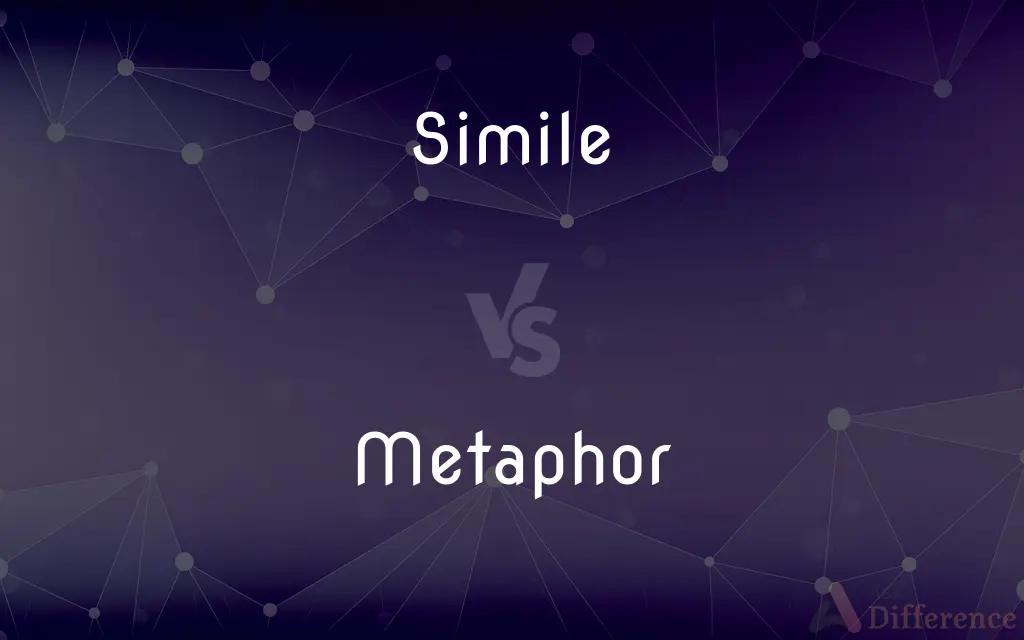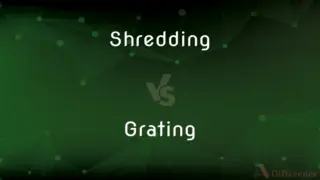Simile vs. Metaphor — What's the Difference?
By Tayyaba Rehman — Updated on September 15, 2023
Simile compares two different things using "like" or "as," implying similarity. Metaphor equates two different things, implying one is the other.

Difference Between Simile and Metaphor
Table of Contents
ADVERTISEMENT
Key Differences
A simile is a figure of speech that directly compares two different things, often by using the words "like" or "as." It serves to highlight a particular quality or characteristic of one thing by comparing it to another. Metaphor, on the other hand, is a figure of speech where a word or phrase is applied to something it's not literally applicable to, suggesting a resemblance.
In a simile, the comparison is explicit. For instance, saying "He fights like a lion" provides a direct comparison between "he" and a "lion," emphasizing bravery or strength. On the contrary, a metaphor would state "He is a lion," which does not directly compare but rather equates the person with a lion in terms of bravery or strength.
One can think of a simile as a subset of metaphor. While all similes are metaphors (because they suggest a form of equivalency), not all metaphors are similes because they don't always use "like" or "as" in the comparison. Thus, while simile always uses a comparative tool, a metaphor directly states the comparison.
Both simile and metaphor enrich language by offering vivid imagery and giving readers or listeners a fresh perspective on a concept or object. While both are tools of comparison, the manner in which they draw parallels differs: simile maintains a distinction between the items, and metaphor merges them into one.
Comparison Chart
Definition
A comparison using "like" or "as"
Directly equates two things
ADVERTISEMENT
Comparative Tools
Always uses "like" or "as"
Doesn't use "like" or "as"
Explicitness
Makes explicit comparisons
Implies or states equivalency
Example
Her smile was like sunshine
The world is a stage
Nature
Subset of metaphors
Broader category
Compare with Definitions
Simile
A literary device to create vivid imagery by juxtaposing two different entities.
His voice was like melted chocolate.
Metaphor
A literary tool that describes an object or action in a way that isn't literally true but helps explain an idea.
The world is an oyster.
Simile
A manner of description that likens one thing to another.
The night sky was as dark as coal.
Metaphor
An expression that equates two things not because they are the same, but for symbolic meaning.
Her heart is gold.
Simile
A figure of speech comparing two unlike things using "like" or "as."
She was as busy as a bee.
Metaphor
A figure of speech in which a word or phrase is applied to an object or action to which it's not literally applicable.
Time is money.
Simile
An expression drawing resemblance with the help of comparative terms.
His words felt like a dagger to her heart.
Metaphor
A means of drawing a parallel between two different things without using a comparative word.
He drowned in a sea of grief.
Simile
An illustrative phrasing that accentuates similarities between two entities.
He roared like a lion in anger.
Metaphor
A direct juxtaposition where qualities of one object are attributed to another.
Life is a roller coaster.
Simile
A simile () is a figure of speech that directly compares two things. Similes differ from other metaphors by highlighting the similarities between two things using comparison words such as "like", "as", "so", or " than", while other metaphors create an implicit comparison (i.e.
Metaphor
A metaphor is a figure of speech that, for rhetorical effect, directly refers to one thing by mentioning another. It may provide (or obscure) clarity or identify hidden similarities between two different ideas.
Simile
A figure of speech in which two essentially unlike things are compared, often in a phrase introduced by like or as, as in "How like the winter hath my absence been" or "So are you to my thoughts as food to life" (Shakespeare).
Metaphor
A figure of speech in which a word or phrase is applied to an object or action to which it is not literally applicable
Her poetry depends on suggestion and metaphor
When we speak of gene maps and gene mapping, we use a cartographic metaphor
Simile
A figure of speech in which one thing is explicitly compared to another, using e.g. like or as.
Figure of speech
Metaphor
A figure of speech in which a word or phrase that ordinarily designates one thing is used to designate another, thus making an implicit comparison, as in "a sea of troubles" or "All the world's a stage" (Shakespeare).
Simile
A word or phrase by which anything is likened, in one or more of its aspects, to something else; a similitude; a poetical or imaginative comparison.
A good swift simile, but something currish.
Metaphor
One thing conceived as representing another; a symbol
"Hollywood has always been an irresistible, prefabricated metaphor for the crass, the materialistic, the shallow, and the craven" (Neal Gabler).
Simile
A figure of speech that expresses a resemblance between things of different kinds (usually formed with `like' or `as')
Metaphor
The use of a word or phrase to refer to something other than its literal meaning, invoking an implicit similarity between the thing described and what is denoted by the word or phrase.
Metaphor
A word or phrase used in such implied comparison.
Metaphor
The use of an everyday object or concept to represent an underlying facet of the computer and thus aid users in performing tasks.
Desktop metaphor; wastebasket metaphor
Metaphor
(intransitive) To use a metaphor.
Metaphor
(transitive) To describe by means of a metaphor.
Metaphor
The transference of the relation between one set of objects to another set for the purpose of brief explanation; a compressed simile; e. g., the ship plows the sea.
Metaphor
A figure of speech in which an expression is used to refer to something that it does not literally denote in order to suggest a similarity
Common Curiosities
What's the primary function of a simile?
To compare two different things using "like" or "as" to highlight a similarity.
How does a metaphor differ from a simile?
A metaphor equates two different things, implying one is the other, without using "like" or "as."
Can a simile be considered a metaphor?
All similes are forms of metaphors, but not all metaphors are similes.
Are metaphors restricted to literary contexts?
No, metaphors are prevalent in daily language, describing emotions, situations, or ideas.
Which is more direct, a simile or a metaphor?
A metaphor is more direct, stating one thing is another.
Can similes and metaphors be used interchangeably?
While both compare, they're used differently; interchangeability depends on the intended imagery.
Is "Her laughter was music to his ears" a simile or metaphor?
It's a metaphor as it doesn't use "like" or "as."
Why are similes commonly used in poetry?
Similes offer vivid imagery, helping convey emotions or describe scenes more effectively.
Why are metaphors powerful in speeches?
Metaphors can convey complex ideas simply, making messages resonate more.
Share Your Discovery

Previous Comparison
Bay vs. Beach
Next Comparison
Shredding vs. GratingAuthor Spotlight
Written by
Tayyaba RehmanTayyaba Rehman is a distinguished writer, currently serving as a primary contributor to askdifference.com. As a researcher in semantics and etymology, Tayyaba's passion for the complexity of languages and their distinctions has found a perfect home on the platform. Tayyaba delves into the intricacies of language, distinguishing between commonly confused words and phrases, thereby providing clarity for readers worldwide.














































